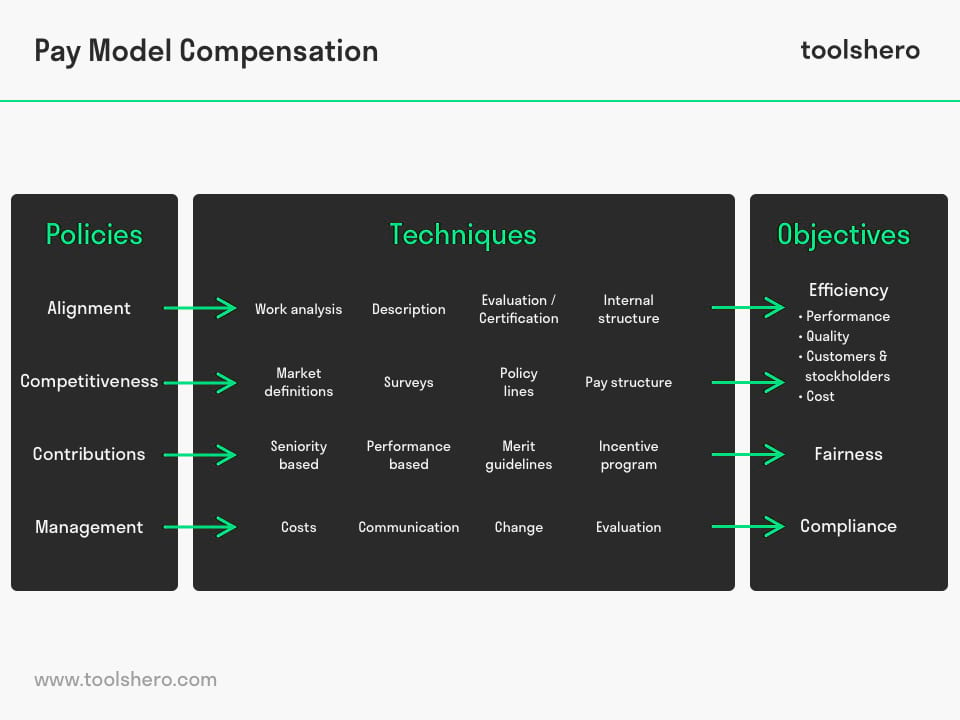Pay Model of Compensation (Milkovich & Newman)

Pay Model Of Compensation: this article provides a practical explanation of the Pay Model Of Compensation by G.T. Milkovich and J.M. Nemwan. Next to what it is, this article also highlights the objectives, the techniques and a short summary. After reading, you’ll understand the basics of this human resource management tool. Enjoy reading!
What is the Pay Model Of Compensation?
The Pay Model of Compensation and benefits helps managers to structurally design and understand the compensation system for their employees.
The model consists of three main components: objective of the remuneration model, the policy that is the foundation for the structure, and the techniques that link the policy to the objectives.
Compensation includes the basic salary as well as rewards in the form of bonuses, overtime, leave, insurance, company car, expense account, and other benefits. The salary calculator does assist managers in compensating employees according to their working hours. The calculator online is a handy resource for managers to calculate the compensation of employees.
Not all compensation models are alike. Some plans put the emphasis on the basic salary, while others are more focused on using performance incentives. Some organisation also offer profit share schemes to their employees if they help to increase production and lower costs.
The compensation model that an organisation uses should match the company SMART goals.
This can help determine which plan is the most beneficial in the long term. This means that elements from different compensation models are sometimes combined.
The remuneration plan also has to be on par with that of the competition or be better. And it’s important to comply with laws and regulations.
The Pay Model of Compensation was developed by G.T. Milkovich and J.M. Nemwan in 2002. They define compensation as forms of financial gain and tangible services and benefits that employees receive as part of their employment.
The model consists of three components: policy, techniques, and objectives.

Figure 1 – Pay Model of Compensation (Milkovich & Newman)
Pay Model of Compensation Objectives
Compensation systems, according to the Pay Model of Compensation, are developed to achieve organisational objectives. As shown in the image, these include efficiency, honesty, and observance of the rules.
Efficiency
Effective remuneration systems contribute to efficiency in the form of improved performance, better quality, satisfied customers, or lower costs.
Fairness
Fairness refers to designing and introducing a reward system that rewards performance and meets the needs of the employees. Fairness is the foundation for healthy work relationships, which means it’s important that employees are treated fairly and get a salary that matches the work they do.
Conformity
Compensation models have to conform to the requirements of various central and national salary legislation and regulations. Conforming with regulations is an integral part of any organisation that wants to act in accordance with the law. When laws change, the compensation system has to be changed as well.
Compensation System Policies
According to the Pay Model of Compensation, the compensation system has to relate to internal consistency, competitive performance, and the contribution of employees. These are the four pillars on which the policy of a compensation structure is based.
1. Alignment
Internal alignment refers to aligning the salaries for similar types of jobs, as well as the rewarding of different kinds of work. Positions are assessed on their relative contribution to the organisation’s objectives.
If the compensation structure is seen as fair by the employees, it will help motivate employees to improve themselves and accept training.
2. External Competitiveness
Competitiveness is about the remuneration plan being competitive enough compared to what competitors are offering. The plan has to offer sufficient benefits for the potential employee to get them interested and keep them. The salaries can’t be too high either, as that would negatively impact competitiveness of the products and services.
3. Contributions
Employee contribution is about how important the performance of the employees is regarding the remuneration model. Strong employee contribution means that incentives and rewards are based on what the employees add.
4. Management
The final component of the four policy methods of the Pay Model Compensation is administration; managing the compensation structure. Efficiency is the goal here as well.
The system has to work well enough to achieve the objectives, and it also needs to be adaptable to react to new requirements. New requirements can be the result of new regulations or new salary objectives for the organisation.
Pay Model of Compensation techniques
The third component of the Pay Model of Compensation are the techniques. These techniques connect policy to objectives.
In order to comply with internal alignment, as the model shows, the techniques are skills and work analysis. In order to meet the competition policy, surveys can be held and market definitions can be created.
The employee contribution is assessed based on performance guidelines. When managing these remuneration plans, communication and change are important factors.
Compensation Models and Corporate Culture
Milkovich’s Pay Model Compensation and the way in which an organisation has set up its remuneration structure says a lot about its culture.
If the rewards is related to what employees add, the culture is performance-driven. The culture is knowledge-driven when the salaries are linked to employee skills, stimulating employees to always develop in order to get a better salary.
In both cases the compensation system should be focused on efficiency. Efficiency will lead to happy customers, better quality, and lower costs. If the pay is based on fairness, and meets the needs of the employee, they will be more motivated. The result will be a loyal staff that makes an effort.
Pay Model of Compensation: different Types of Compensation
There are several popular forms of compensation. It’s up to the employer to put together a selection of benefits that suit the company goals and the employee’s needs. Examples of compensation are:
Basic salary
The basic salary is the starting salary that is paid to an employee. This does not yet include any additional benefits. It’s the remuneration an employee receives for their services for the company. The basic salary of an employee can be expressed in an hourly wage, or in a monthly or annual salary.
Commission
Commission refers to another type of compensation. It consists of the basic salary an employee receives together with other types of compensation that are paid for their work. This is often after reaching a certain target, such as selling a specific number of products or services.
Overtime Pay
This rule ensures that employees are properly compensated for the hours they work that exceed their contract. These hours are often not worked voluntarily, nor are they paid. That’s illegal in many countries and arranged by law.
Bonuses, Profit Sharing
The bonus salary is the remuneration that is higher than the basic salary or hourly wage. Employers have the option to distribute these bonuses throughout the organisation as they see fit, for instance for demanding positions with a lot of responsibility. They should always match the company objectives, however
Stock Options
Profit sharing is another reward programme used by organisations. It entails employees getting a share of the profits. The amount they get is based on the profit made by the business during a certain period. Usually it’s awarded annually.
Travel/ Meal/ Housing Expense Reimbursement
There are other forms of compensation that are offered to employees. Think of travel expenses, money for meals, or other expense reimbursement. Travel expenses are usually compensated based on an amount per kilometre travelled.
Other Benefits
Other benefits are:
- Dental insurance
- Health insurance
- Personal insurance
- Medical insurance
- Leave days
- Pension schemes
- Tax benefits
To Summarise the Pay Model of Compensation
The Pay Model Compensation by Milkovich & Newman gives a structured way of how compensation systems should be organised. The model consists of three components: objective of the remuneration model, the policy that is the foundation for the structure, and the techniques that link the policy to the objectives.
A remuneration system has to be sufficiently competitive and strive for compliance with laws and regulations. There are different types of compensation. The total remuneration plan consists of a basic salary, commissions, bonuses, or other benefits.
Now It’s Your Turn
What do you think? Do you recognise the explanation of the Pay Model Compensation? Which forms of compensation do you receive from your employer? How important do you think it is that employee motivation is suitably compensated? Do you have any tips or additional comments?
Share your experience and knowledge in the comments box below.
More information
- Carpenter, M. A., & Sanders, W. G. (2002). Top management team compensation: The missing link between CEO pay and firm performance?. Strategic management journal, 23(4), 367-375.
- Daily, C. M., Johnson, J. L., Ellstrand, A. E., & Dalton, D. R. (1998). Compensation committee composition as a determinant of CEO compensation. Academy of Management Journal, 41(2), 209-220.
- Milkovich, G. T., Newman, J. M., & Milkovich, C. (2002). Compensation (Vol. 8). New York: McGraw-Hill.
- Wowak, A. J., & Hambrick, D. C. (2010). A model of person‐pay interaction: how executives vary in their responses to compensation arrangements. Strategic Management Journal, 31(8), 803-821.
How to cite this article:
Janse, B. (2019). Pay Model of Compensation (Milkovich & Newman). Retrieved [insert date] from Toolshero: https://www.toolshero.com/human-resources/pay-model-compensation/
Original publication date: 07/30/2019 | Last update: 04/17/2024
Add a link to this page on your website:
<a href=”https://www.toolshero.com/human-resources/pay-model-compensation/”>Toolshero: Pay Model of Compensation (Milkovich & Newman)</a>










